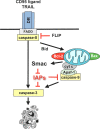Betulinic Acid for cancer treatment and prevention
- PMID: 19325847
- PMCID: PMC2658785
- DOI: 10.3390/ijms9061096
Betulinic Acid for cancer treatment and prevention
Abstract
Betulinic acid is a natural product with a range of biological effects, for example potent antitumor activity. This anticancer property is linked to its ability to induce apoptotic cell death in cancer cells by triggering the mitochondrial pathway of apoptosis. In contrast to the cytotoxicity of betulinic acid against a variety of cancer types, normal cells and tissue are relatively resistant to betulinic acid, pointing to a therapeutic window. Compounds that exert a direct action on mitochondria present promising experimental cancer therapeutics, since they may trigger cell death under circumstances in which standard chemotherapeutics fail. Thus, mitochondrion-targeted agents such as betulinic acid hold great promise as a novel therapeutic strategy in the treatment of human cancers.
Keywords: AIF, apoptosis inducing factor; Apaf-1, Apoptotic protease activating factor-1; BA, betulinic acid; DIABLO, direct IAP Binding protein with Low PI; HtrA2, high temperature requirement protein A; IAPs, Inhibitor of Apoptosis Proteins; MOMP, mitochondrial outer membrane permeabilization; PARP, Poly (ADP-ribose) Polymerase; ROS, reactive oxygen species; Smac, second mitochondria-derived activator of caspase; TNF, tumor necrosis factor; TRAIL, tumor necrosis factor-related apoptosis-inducing ligand; apoptosis; betulinic acid; cancer; mitochondria; zVAD.fmk, N-benzyloxycarbonyl-Val-Ala-Asp-fluoromethylketone.
Figures


Similar articles
-
Betulinic acid: a natural product with anticancer activity.Mol Nutr Food Res. 2009 Jan;53(1):140-6. doi: 10.1002/mnfr.200700491. Mol Nutr Food Res. 2009. PMID: 19065582 Review.
-
Targeting mitochondrial apoptosis by betulinic acid in human cancers.Drug Discov Today. 2009 Sep;14(17-18):885-90. doi: 10.1016/j.drudis.2009.05.015. Epub 2009 Jun 9. Drug Discov Today. 2009. PMID: 19520182 Review.
-
X-linked inhibitor of apoptosis (XIAP) blocks Apo2 ligand/tumor necrosis factor-related apoptosis-inducing ligand-mediated apoptosis of prostate cancer cells in the presence of mitochondrial activation: sensitization by overexpression of second mitochondria-derived activator of caspase/direct IAP-binding protein with low pl (Smac/DIABLO).Mol Cancer Ther. 2002 Oct;1(12):1051-8. Mol Cancer Ther. 2002. PMID: 12481428
-
Etoposide upregulates Bax-enhancing tumour necrosis factor-related apoptosis inducing ligand-mediated apoptosis in the human hepatocellular carcinoma cell line QGY-7703.Eur J Biochem. 2003 Jul;270(13):2721-31. doi: 10.1046/j.1432-1033.2003.03639.x. Eur J Biochem. 2003. PMID: 12823542
-
Smac mimetic primes apoptosis-resistant acute myeloid leukaemia cells for cytarabine-induced cell death by triggering necroptosis.Cancer Lett. 2014 Mar 1;344(1):101-109. doi: 10.1016/j.canlet.2013.10.018. Epub 2013 Oct 30. Cancer Lett. 2014. PMID: 24184825
Cited by
-
Cytotoxic Potential of Betulinic Acid Fatty Esters and Their Liposomal Formulations: Targeting Breast, Colon, and Lung Cancer Cell Lines.Molecules. 2024 Jul 19;29(14):3399. doi: 10.3390/molecules29143399. Molecules. 2024. PMID: 39064977 Free PMC article.
-
The Mediterranean Diet, a Rich Source of Angiopreventive Compounds in Cancer.Nutrients. 2019 Aug 31;11(9):2036. doi: 10.3390/nu11092036. Nutrients. 2019. PMID: 31480406 Free PMC article. Review.
-
Polyethyleneglycol-Betulinic Acid (PEG-BA) Polymer-Drug Conjugate Induces Apoptosis and Antioxidation in a Biological Model of Pancreatic Cancer.Polymers (Basel). 2023 Jan 14;15(2):448. doi: 10.3390/polym15020448. Polymers (Basel). 2023. PMID: 36679328 Free PMC article.
-
Natural Compounds As Modulators of Non-apoptotic Cell Death in Cancer Cells.Curr Genomics. 2017 Apr;18(2):132-155. doi: 10.2174/1389202917666160803150639. Curr Genomics. 2017. PMID: 28367073 Free PMC article.
-
Phytochemical and Ethnopharmacological Perspectives of Ehretia laevis.Molecules. 2021 Jun 8;26(12):3489. doi: 10.3390/molecules26123489. Molecules. 2021. PMID: 34201193 Free PMC article. Review.
References
-
- Newman DJ, Cragg GM, Snader KM. Natural products as sources of new drugs over the period 1981–2002. J. Nat. Prod. 2003;66:1022–1037. - PubMed
-
- Evan GI, Vousden KH. Proliferation, cell cycle and apoptosis in cancer. Nature. 2001;411:342–348. - PubMed
-
- Hanahan D, Weinberg RA. The hallmarks of cancer. Cell. 2000;100:57–70. - PubMed
-
- Galluzzi L, Larochette N, Zamzami N, Kroemer G. Mitochondria as therapeutic targets for cancer chemotherapy. Oncogene. 2006;25:4812–4830. - PubMed
-
- Cichewicz RH, Kouzi SA. Chemistry, biological activity, and chemotherapeutic potential of betulinic acid for the prevention and treatment of cancer and HIV infection. Med. Res. Rev. 2004;24:90–114. - PubMed
LinkOut - more resources
Full Text Sources
Other Literature Sources
Research Materials
Miscellaneous

